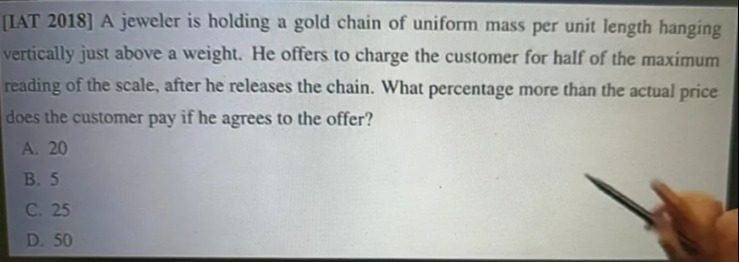Question
Question: A jeweler is holding a gold chain of uniform mass per unit length hanging vertically just above a we...
A jeweler is holding a gold chain of uniform mass per unit length hanging vertically just above a weight. He offers to charge the customer for half of the maximum reading of the scale, after he releases the chain. What percentage more than the actual price does the customer pay if he agrees to the offer?

20
5
25
50
50
Solution
Let L be the total length of the gold chain and λ be its uniform mass per unit length. The total mass of the chain is M=λL. The actual price of the chain is proportional to its mass, so Pactual∝M.
The chain is held vertically just above a weight scale and released. As the chain falls, segments of it land on the scale. The scale reading measures the force exerted on it. This force consists of two parts:
- The weight of the portion of the chain that has already landed on the scale.
- The force due to the impact of the falling chain segments as they come to rest on the scale.
Let y be the length of the chain that has fallen onto the scale at time t. We assume the chain is released from rest with its lowest end just touching the scale. As the chain falls, the top end also falls. The distance fallen by the top end is equal to the length of the chain that has landed on the scale, which is y.
The speed v of the falling chain when a length y has landed is given by v=2gy, assuming it falls under gravity from rest.
The mass of the chain that has landed on the scale is mlanded=λy. The weight of this portion is W=mlandedg=λyg.
The rate at which mass is landing on the scale is dm/dt=λ(dy/dt). Since the speed at which the chain is landing is v=dy/dt, we have dm/dt=λv.
The momentum of a small segment of mass dm just before it lands is dm⋅v. After landing, its momentum is 0. The change in momentum is 0−dm⋅v.
The force exerted by the scale to stop this segment is Fstop=dtd(momentum)=dtd(dm⋅v). Since the velocity v is constant for the falling part at a given instant, and mass is added, the force is Fstop=vdtdm.
By Newton's third law, the force exerted by the landing chain on the scale (impact force) is Fimpact=−Fstop=vdtdm.
Substituting dm/dt=λv, we get Fimpact=v(λv)=λv2.
Using v2=2gy, the impact force is Fimpact=λ(2gy)=2λgy.
The total force exerted on the scale at time t, when a length y has landed, is the sum of the weight of the landed portion and the impact force:
Fscale(y)=W+Fimpact=λyg+2λgy=3λgy.
This force is valid as long as the entire chain has not landed, i.e., for 0≤y≤L.
The maximum reading of the scale occurs when y is maximum, which is y=L.
The maximum force on the scale is Fmax=3λgL.
The scale reading is typically given in units of mass, which is the force divided by g.
Maximum reading of the scale in mass units is Rmax=gFmax=g3λgL=3λL.
Since the total mass of the chain is M=λL, the maximum reading is Rmax=3M.
The jeweler offers to charge the customer for half of the maximum reading of the scale.
The mass the customer is charged for is Mcharged=21Rmax=21(3M)=23M.
The actual mass of the chain is Mactual=M.
The actual price is proportional to the actual mass, Pactual∝M. Let Pactual=cM for some constant c.
The charged price is proportional to the charged mass, Pcharged=cMcharged=c23M.
The amount the customer pays more than the actual price is Pcharged−Pactual=c23M−cM=c(23−1)M=c21M.
The percentage more than the actual price that the customer pays is:
PactualPcharged−Pactual×100%=cMc21M×100%=11/2×100%=50%.
The customer pays 50% more than the actual price.
